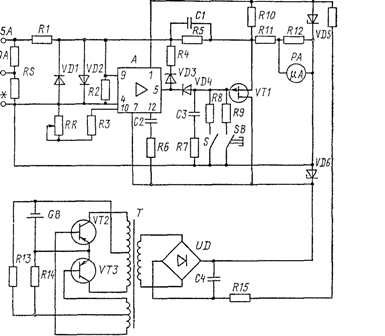How to measure the current flowing through an electrical circuit for a short time
 To measure the current passing for a short time (fractions of a second) through an electrical circuit, ammeters with memory elements (storage ammeters) are needed, in which the pointer arrow remains in a position indicating the current for some time after it has passed through the electrical circuit .
To measure the current passing for a short time (fractions of a second) through an electrical circuit, ammeters with memory elements (storage ammeters) are needed, in which the pointer arrow remains in a position indicating the current for some time after it has passed through the electrical circuit .
The memory ammeter contains an operational amplifier of the type 140UD1 in the form of a monolithic integrated circuit (IC), a memory cell C3, R7, indicating the RA device and a power supply from a transformer converter VT2, VT3 and a rectifier UD. The ammeter is connected to the controlled circuit via terminals * and 5A or * and 10A of the RS shunt.
When measuring current, the RS shunt voltage is applied to the IC input (pins 9, 4, 10). From the output of the IC (pin 5), a constant voltage is applied to the memory cell C3, R7 and the gate of the field-effect transistor VT1.As the current in the measured circuit increases, the voltage at the output of the IC increases, and the current passing through the field-effect transistor VT1, corresponding to the current of the monitored circuit, is recorded by the RA device. At the end of the current flow through the controlled circuit, the voltage is turned on capacitor C3 and the reading of the RA device remains unchanged for a long time.
After reading the readings of the RA device, the stored value is erased by pressing the SB button (capacitor C3 is discharged through resistor R9). Switch S serves to turn off the memory cell, which, when turned on, is short-circuited with resistor R8.
Such a device is convenient, in particular, when measuring the tripping current of the instantaneous release of a circuit breaker, when it is necessary to very quickly increase the current in its winding to the tripping current in order to avoid overheating of the regulating device.

Schematic of a storage ammeter
